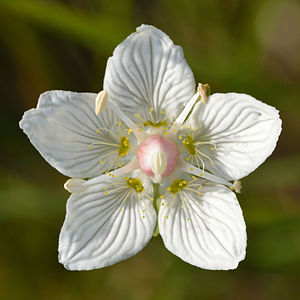ἄγρωστις: Difference between revisions
αἰτήσεις ἀκοὐεις σῶν ἱκετῶν· ταχἐως συνδραμεῖς ἀναπαὐων εὐεργετῶν· ἰάματα παρἐχεις, Ἱερἀρχα, τῇ πρὀς Θεὀν παρρησἰᾳ κοσμοὐμενος → You hear the prayers of your suppliants; quickly you come to their assistance, bringing relief and benefits; you provide the remedies, Archbishop, since you are endowed with free access to God.
m (Text replacement - "‘([\w\s]+)’" to "‘$1’") |
m (Text replacement - "(*UTF)(*UCP)(:''' εως ἡ) ([\p{Cyrillic}\s]+) ([a-zA-Z\(])" to "$1 $2 $3") |
||
| Line 30: | Line 30: | ||
}} | }} | ||
{{elru | {{elru | ||
|elrutext='''ἄγρωστις:''' εως ἡ кормовая трава Hom., Theocr. | |elrutext='''ἄγρωστις:''' εως ἡ [[кормовая трава]] Hom., Theocr. | ||
}} | }} | ||
{{etym | {{etym | ||
Revision as of 14:50, 2 September 2022
English (LSJ)
ιδος, Thphr. HP1.6.10, and εως, Arist.HA552a15, PTeb.104.26 (ii B. C.), ἡ, acc. A ἄγρωστιν Plb.34.10.3, Str.4.1.7:—dog's-tooth grass, Bermuda grass, Dhoob, dūrvā grass, ethana grass, dubo, dog's tooth grass, Bahama grass, devil's grass, couch grass, Indian doab, arugampul, grama, wiregrass, scutch grass, Cynodon dactylon, ἄγρωστις μελιηδής Od.6.90; εἱλιτενὴς ἄγρωστις Theoc.13.42, cf. Aeschrio 6, D.S. 1.43, Dsc.4.29. 2 ἄγρωστις ἐν Κιλικίᾳ = sea barley, seaside barley, Hordeum marinum, Dsc.4.32; ἄγρωστις ἐν Παρνασσῷ = marsh grass of Parnassus, northern grass-of-Parnassus, grass-of-Parnassus, bog star, grass of Parnassus, Parnassia palustris, ib.31.
German (Pape)
[Seite 25] εως, ἡ, Futterkraut, Quecken, μελιηδής Od. 6, 90 (ἅπαξ εἰρημ.); – εἱλιτενής Theocr. 13, 42; Theophr.
Greek (Liddell-Scott)
ἄγρωστις: -ιδος, Θεόφρ. Ἱ. Φ. 1. 6, 10, καὶ -εως, ἡ, = βοτάνη, ἣν τρώγουσιν αἱ ἡμίονοι («ἀγριάδα»)· τρώγειν ἄγρ. μελιηδέα, Ὀδ. Ζ. 90· εἱλιτενὴς ἄγρ., Θεόκρ. 13. 42: - Κατὰ τοὺς ἑρμηνευτὰς τοῦ Θεοφρ. 1. Φ. 1. 6. 7. κτλ., ἡ βοτάνη αὕτη εἶναι ἡ Λατινιστὶ ὀνομαζομένη triticum repens. II. Περὶ τοῦ ἀγρῶστις ἴδε ἀγρώστης, ΙΙ.
French (Bailly abrégé)
ιδος et εως (ἡ) :
chiendent, plante.
Étymologie: DELG ἀγρός, pê influencé par γράστις.
English (Autenrieth)
field-grass, grass; identified by some with ‘dog's tooth,’ by others with ‘panic.’
Spanish (DGE)
-ιδος, ἡ
• Morfología: ac. -ιν Plb.34.10.3, Str.4.1.7; gen. -εως Arist.HA 552a15, Plb.34.10.3, PTeb.105.26 (II a.C.), PMerton 68.33 (II d.C.)
bot.
1 grama, Cynodon dactylon (L.) Pers., en gener. césped, hierba de los prados ἄ. μελιηδής Od.6.90, εἰλιτενὴς ἄ. Theoc.13.42, πεδίον ... πολλὴν ἄ. ἔχον Plb.34.10.3, cf. Aeschrio 5, Arist.HA 552a15, Dsc.4.29, Ps.Apul.Herb.78.11, PMerton l.c., 238.30 (II d.C.)
•con sent. peyor. mala hierba ἀνατελεῖ ὡς ἄγρωστις κρίμα ἐπὶ χέρσον ἀγροῦ germinará el castigo como la mala hierba en los surcos del campo LXX Os.10.4
•como amuleto contra los encantamientos, Ael.NA 1.35.
2 ἄ. ἐν τῷ Παρνασσῷ parnasia, hepática blanca, Parnassia palustris L., Dsc.4.31.
3 (ἄ.) ἐν Κιλικίᾳ cebada borde, Hordeum marinum L., Dsc.4.32.
• Etimología: Quizá de *ghreHu̯3- ‘crecer’, v. aisl. grōði ‘crecimiento’, ags. grōwan ‘hacerse verde’.
Greek Monotonic
ἄγρωστις: -ιδος και -εως, ἡ, χορτάρι, η «αγριάδα» που τρώνε τα μουλάρια, σε Ομήρ. Οδ., Θεόκρ.
Russian (Dvoretsky)
ἄγρωστις: εως ἡ кормовая трава Hom., Theocr.
Frisk Etymological English
-ιδος, -εως
Grammatical information: f.
Meaning: dogs-tooth grass (Od.)
Origin: IE [Indo-European] [287] *h₁ed- to eat.
Etymology: Supposed to be the fem. of ἀγρώστης countryman, from ἀγρός. Bechtel Lex. s.v., Strömberg Pflanzennamen 117. Cf. also Kalitsunakis apud Kretschmer Glotta 3, 315f. Meier-Brügger, KZ 103 (1990) 33f. explains the word as *h₂eǵro-h₁d-tis Feld-Futter, which seems unobjectionable.
Middle Liddell
Subst. and adj., Soph., Eur., a grass that mules fed on.
Frisk Etymology German
ἄγρωστις: -ιδος, -εως
{ágrōstis}
Meaning: Feldkraut (ζ 90 usw.),
Etymology: Fem. von ἀγρώστης, s. ἀγρός. Bechtel Lex. s. v., Strömberg Pflanzennamen 117. Vgl. auch Kalitsunakis bei Kretschmer Glotta 3, 315f.
Page 1,16
Wikipedia EN
Parnassia palustris, commonly called marsh grass of Parnassus, northern grass-of-Parnassus, or just grass-of-Parnassus, and bog star, is a flowering plant in the staff-vine family Celastraceae. It is the county flower of Cumberland in England, and appears on its flag. The name comes from ancient Greece: evidently the cattle on Mount Parnassus appreciated the plant; hence it was an "honorary grass". The species epithet palustris is Latin for "of the marsh" and indicates its common habitat. It was described by the Greek physician Dioscorides, growing up a mountain in 1st century A.D.
Hordeum marinum, commonly known as sea barley or seaside barley, is a species of grass.
Translations
Cynodon dactylon
af: kweekgras; am: ሰርዶ; ar: ثيل; as: দুবৰি বন; az: barmaqvari çayır; be: свінарый пальцавы; bn: দূর্বা; ca: grama; cy: glaswellt bermwda; de: Hundszahngras; el: αγριάδα; eu: askimotz; fa: چایر; fi: varvasheinä; fr: chiendent pied-de-poule; gom: हरयाळी; gu: ધરો; he: יבלית; hi: दूब घास; hu: csillagpázsit; ja: ギョウギシバ; ka: გლერტა; kk: бессаусақ қарашағыр; kn: ಗರಿಕೆಹುಲ್ಲು; ko: 우산잔디; ky: ажырык; ml: കറുക; nap: ramegna; ne: दूबो; nl: handjesgras; or: ଦୁବ; pl: cynodon palczasty; pnb: کھبل; qu: chipika; ru: свинорой пальчатый; sat: ᱫᱷᱩᱵᱤ ᱜᱟᱥ; sa: दूर्वा; sr: zubača; su: kakawatan; sv: hundtandsgräs; ta: அறுகு; tcy: ಕದಿಕೆ ಪಂತಿ; tg: аҷириқ; th: หญ้าแพรก; to: musie; uk: свинорий пальчастий; uz: ajriq; vi: cỏ gà; wuu: 狗牙根; zh_yue: 狗牙草; zh: 狗牙根
Parnassia palustris
be: відомец балотны; ca: fetgera blanca; csb: dzewikwiat; cs: tolije bahenní; cy: brial y gors; da: leverurt; de: Sumpf-herzblatt; et: harilik ädalalill; fa: آلاله سفید; fi: vilukko; fr: parnassie des marais; hsb: bahnowy jenačk; hu: fehérmájvirág; is: mýrasóley; ja: ウメバチソウ; lt: pelkinė mandrauninkė; lv: purva atālene; nl: parnassia; nn: jåblom; no: jåblom; pl: dziewięciornik błotny; ru: белозор болотный; sah: чэмэлиидэ; se: beivečalbmi; sh: talija; sl: močvirna samoperka; sr: талија; sv: slåtterblomma; tt: саз тавыкчәчәге; uk: білозір болотний; zh: 梅花草



